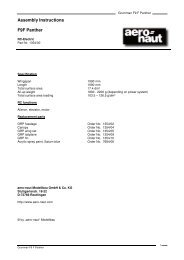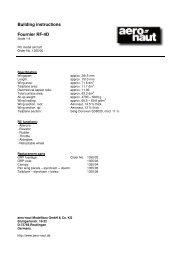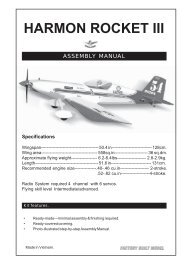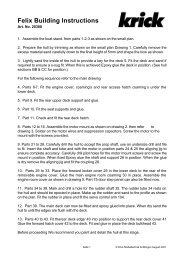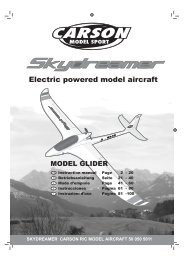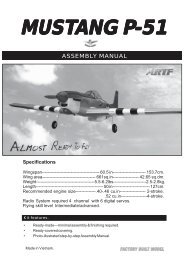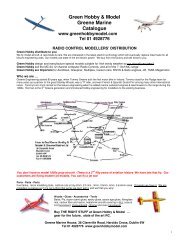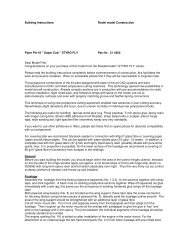GREEN HOBBY Assembly Notes for "DAISY" - Green Hobby & Model
GREEN HOBBY Assembly Notes for "DAISY" - Green Hobby & Model
GREEN HOBBY Assembly Notes for "DAISY" - Green Hobby & Model
Create successful ePaper yourself
Turn your PDF publications into a flip-book with our unique Google optimized e-Paper software.
<strong>GREEN</strong> <strong>HOBBY</strong> Part No. Daisy G/E/Q<br />
Building Instructions RC- Electric Aircraft "DAISY"<br />
Motor or Glider Version<br />
Technical In<strong>for</strong>mation:<br />
Wingspan: 1480 mm<br />
Length: 850 mm<br />
Wing Airfoil Design: S 7055<br />
Total Area: 24.1 dm 2<br />
Flight Weight: 450 g Glider<br />
800 g Electric<br />
Electric Version: 1 AeroNaut Race 400 6.0V Motor Part No 7000/42<br />
2 AeroNaut Race 480 7.2V Black Power Part No 7000/48<br />
3 Mega Motor Brushless Mega 16.15.4 or Mega 400.12.<br />
Nimh Battery: 8 cells choice of three - Part Nos KAN1050/GP1100/GP2000<br />
Propeller: Folding 6x3" Glass + Integral Middlepiece Part No 7235/05<br />
Or 6x3" Carbon + Integral Middlepiece Part No 7236/05<br />
Or…. brushless option 7 x 4.5 blades + 3.2mm integral spinner<br />
<strong>Assembly</strong> <strong>Notes</strong> <strong>for</strong> "DAISY"<br />
Be<strong>for</strong>e opening the glue, oil the threads on all bolts with "After-Run" oil (available from <strong>Green</strong> <strong>Hobby</strong>),<br />
this prevents all kind of problems later! Wherever instructions suggest gluing to the epoxy fuselage, preroughen<br />
up the smooth epoxy with fine sandpaper to give the glue a better "key" to adhere onto.<br />
USEFUL TOOLS:<br />
Needle or point nose pliers; "pin vise" modellers drill, drill bits from 2mm to 4mm, needle files, small wire<br />
cutters, scalpel set, a little oil, epoxy glue, matchsticks <strong>for</strong> introducing epoxy into difficult to reach places,<br />
soldering iron with electronic grade solder & flux paste, connecting plugs <strong>for</strong> nimh battery connections to<br />
speed controller. All modelling tools are available from <strong>Green</strong> <strong>Hobby</strong>, and once purchased, will last you<br />
<strong>for</strong> many years.<br />
SAFETY: All electric aircraft have self start capability, this is absent in glow engined models. Because<br />
of this both new modellers and modellers new to electric flight should always bear in mind the possibility<br />
of the prop beginning to spin unexpectedly, if there is a nimh battery connected up. We call plugging in<br />
the nimh "arming the plane", if your plane is armed, the transmitter should be "ON" to shout down<br />
background interference that might switch the motor on. Ensure throttle stick is at down-throttle off.<br />
The plane should be on a stand, so the prop is free to spin, and the motor will not burn out due to a<br />
stalled prop. The modeller should also never stand to the side of a spinning prop - in front OK (if the<br />
plane is stationery!), behind OK (recommended), but never to the side, a prop blade (or stone) could fly<br />
out at high speed without warning, injuring anybody present there.<br />
Remember: this is a REAL aircraft, it will be dangerous if not used carefully. Keep away from<br />
bystanders. Even when being used properly, mishaps will occasionally happen, so due caution should<br />
be exercised. Give respect to the propeller which is extremely sharp, the batteries which if shorted can<br />
cause fire, the aircraft which needs maintenance be<strong>for</strong>e flights, your piloting skills which will improve but<br />
never achieve perfection, and radio interference. In short - allow <strong>for</strong> problems and fly safely.<br />
TAIL: Locate the two pairs of<br />
holes in the top of the epoxy<br />
fuselage, near the tail. The<br />
rearward pair are tapped with a<br />
thread to accept bolts holding the<br />
stabiliser-elevator on later. The<br />
<strong>for</strong>ward pair of holes, not tapped<br />
give you correct location of the<br />
vertical stabiliser fin-rudder.<br />
Using a Stanley knife or scalpel,<br />
make two cuts joining the <strong>for</strong>ward<br />
pair of holes, and remove the thin<br />
strip of epoxy, making a slot. Now<br />
you can trial fit your fin, sanding<br />
the slot with a fine file, or scraping<br />
with the scalpel <strong>for</strong> best fit.
Now fit the flat stabiliser -elevator onto the rearward tapped holes with two nylon bolts. You can now<br />
see the clear space required under the vertical fin <strong>for</strong> flat stabiliser's free movement in flight. Trial fit fin<br />
again until completely satisfied.<br />
To fit the fin, apply epoxy to three<br />
places - the fin sides above the<br />
epoxy fuselage, the fin sides under<br />
the epoxy fuselage, and the fin base<br />
with epoxy gluing it to the fuselage<br />
floor at the front edge of the fin.<br />
A matchstick is handy <strong>for</strong> application<br />
of glue to the difficult to reach places.<br />
The best position is with the <strong>for</strong>ward<br />
edge of the fin base lower, touching<br />
the fuselage floor. Lift the underside<br />
of the fin's trailing edge up slightly by<br />
resting the hinged rudder part on a<br />
piece of matchstick until the glue<br />
sets. This allows better access to<br />
remove the elevator bolts after<br />
completion, <strong>for</strong> easier transport of<br />
your aircraft.<br />
When happy, wipe off excess glue and leave to harden, with the fin in a perfectly vertical orientation.<br />
Try to keep the amount of epoxy used to a minimum, it's heavy! Try also to avoid getting epoxy on the<br />
flat stabiliser nylon bolts inside the fuselage, you pre-oiled them but even so don't take chances of<br />
gluing them in permanently!<br />
WINGS: Trial fit the wing pegs in wing holes. The front edges are best sanded slightly rounded <strong>for</strong><br />
easier fit into fuselage holes. If too tight the wing can not be put correctly onto the fuselage. So take a<br />
little time here. Ease the fit (if necessary) by using a 4mm drill bit gently in a "pin vice drill" or between<br />
your fingertips. Only when you can locate the pegs in the holes in the fuselage AND press the wing<br />
trailing edge down so the nylon wing bolts can be screwed home without danger of breakage, THEN you<br />
are ready to glue.<br />
Oil the peg holes in the epoxy fuselage. The pegs have a tendency to slide too far into the wings while<br />
dry fitting the wings, so try to have them go into the oiled fuselage holes without being pushed back into<br />
the wing holes. Epoxy the pegs into the wings, wipe off excess epoxy, fit wings until glue sets.<br />
After pegs harden into wing, remove the wings <strong>for</strong> convenience during the rest of the assembly.<br />
MOTOR: This is pre-fitted in some versions of the kit. If not ask the <strong>Green</strong> <strong>Hobby</strong> team <strong>for</strong> an AeroNaut<br />
6.0V Race 400 direct drive motor. The motor is fitted using two steel 2.5x8mm machine bolts. A<br />
downward tilt, or downthrust is noticeable, this is intentional, and indeed is necessary <strong>for</strong> the excellent<br />
flying characteristics of the aircraft on full power. If the prop is not pre-fitted, test the motor <strong>for</strong> free<br />
rotation be<strong>for</strong>e fitting. Draw centreline on wood. Drill two 2.5mm holes 3mm out from the centre hole in<br />
mounting plate.<br />
It can happen that the motor mounting bolts reach sufficiently far into the motor that they foul the rotor<br />
and prevent it spinning (stalled prop). If this happens, applying power will burn out your motor, so always<br />
test the motor spins free be<strong>for</strong>e applying power. The cure is simple, add a couple of 3mm washers<br />
under the bolt heads be<strong>for</strong>e the bolt goes through the hardwood motor mounting plate, this shortens the<br />
length of bolt inside the motor, preventing any problem.<br />
PROPELLER: Installation of the types of propeller supplied by <strong>Green</strong> <strong>Hobby</strong> is simple. It is pre-installed<br />
on most non-aileron versions of the DAISY. Assemble the prop and fit onto the motor shaft with the<br />
Allen keys supplied. Do not overtighten or you might "pull" the threads in the plastic prop assembly. Try<br />
to have a 1 to 1.5mm gap between the propeller rear and the fuselage front, this aids cooling, prevents<br />
the bolt heads fouling the prop, (same problem as <strong>for</strong> the motor bolts!), and also gives a tiny shock<br />
absorber in bumpy landings as the prop can "give" a little as it slides back under the impact. Remember<br />
to release the prop from possible locking up after any nose down landings however! The free-spinning<br />
prop test <strong>for</strong> the motor finds any problems here, be<strong>for</strong>e power is applied.<br />
ELECTRONIC SPEED CONTROLLER: This is pre-fitted on most non-aileron versions of DAISY. The<br />
polarity of speed controller-to-motor connection is not vital to the life of the speed controller. This<br />
determines the direction of prop rotation. The polarity of speed controller-to-nimh battery connection IS<br />
VITAL if you get this wrong even <strong>for</strong> a split second you will short out the speed controller and destroy it.<br />
No warranty will cover this damage. Read the manufacturers instructions carefully.<br />
Solder on appropriate connecting plugs that prevent plugging in the wrong way round. Red-to-red -<br />
positive (+), black-to-black-negative (-). Cover bare solder-wire ends with heatshrink of the correct
colour (red/black), then the wires can not touch even while hanging-swinging round inside your model.<br />
<strong>Green</strong>e <strong>Hobby</strong> has suitable plugs and heatshrink <strong>for</strong> this.<br />
Don't try "testing" the motor holding the wires together in your hand - accidents happen.<br />
NIMH Battery Electric Version: This is fitted using two postage stamp size patches of VELCRO on the<br />
Nimh, and a 200mm strip of VELCRO on the fuselage base/lower sides. The idea is to be able to stick<br />
the battery in the exact place that gets the aircraft balanced, see later.<br />
You will get surprisingly long flights with the recommended nimh battery from your DAISY, it's height<br />
retention is very good, even when turning.<br />
At <strong>Green</strong> <strong>Hobby</strong> we have tried many batteries <strong>for</strong> balance and per<strong>for</strong>mance while testing prototypes.<br />
We found that, of the many batteries available, three nimh packs give equally nice flying but give<br />
different duration. One is slightly heavier, so they serve the dual function of steadying DAISY in variable<br />
windy conditions. These 1050 mAh, 1100mAh and 2000 mAh DAISY nimhs are available from <strong>Green</strong><br />
<strong>Hobby</strong>. Both are easily fitted and removed from the fuselage <strong>for</strong> charging.<br />
Glider Version Battery: In the Daisy Glider version, the weight of the missing motor must be<br />
compensated <strong>for</strong>. So if you are fitting Daisy as a glider, the battery (4 cell receiver battery) goes in the<br />
nose, and is held by blue tack putty. Add enough blue tack, so that the centre of gravity is identical to<br />
motor version as explained later.<br />
CONTROL CABLES & HORNS: Make a “Z” bend in one end of each steel inner cable (3mm between<br />
90°bends). Cut each white outer 2 cm shorter than its steel inner. Slide inner into outer. Slide elevator<br />
cable from tail up fuselage inside to servo area. Hook elevator control horn onto Z bend with flat<br />
edge/holes to front, with holes adjacent with elevator hinge line. Trial fit, make pin pricks <strong>for</strong> horn<br />
screws, drill elevator 2mm <strong>for</strong> screws, install control horn under elevator using screw receiver plate <strong>for</strong><br />
top of elevator. Horn may be glue-on type, if so, just drill an appropriate size hole and glue it into the<br />
wood. Slide white outer so that it ends 1cm away from control horn (just inside fuselage end), and<br />
carefully put a drop of epoxy on the outer 1/2 cm further inside, bonding outer to fuselage floor. Use a<br />
wood strip <strong>for</strong> this and get no glue on the steel inner or controls will not work. Consider oiling the steel<br />
inner <strong>for</strong> added safety, but take care because if oil gets on the outer, the glue will not bond outer<br />
correctly to the fuselage.<br />
Epoxy fuselage must be drilled <strong>for</strong> rudder cable. Locate the spot, 6mm to side of fin, and adjacent to the<br />
rear end of the fin base on the fuselage outside. Drill 2mm <strong>for</strong> rudder cable. Open up the hole to an<br />
oval shape by redrilling at the angle the cable will take. The pin vice is excellent <strong>for</strong> this job. Trial fit<br />
rudder cable. If necessary use a rat tail needle file to free cable outer. The cable should point towards<br />
the place where the control horn will be when installed.<br />
This ensures that there is no sharp corner/bend in the cable that makes the steel inner tight in its<br />
movements. A tight cable uses excessive servo power and shortens flight duration.<br />
Slide control horn onto Z bend, flat edge <strong>for</strong>ward, and trial fit control horn as be<strong>for</strong>e, with flat edge inline<br />
with rudder hinge, in such a way that the cable points to the place of installation. Estimated location <strong>for</strong><br />
horn is near base of rudder with rear end of horn raised 2mm more than front so horn is inline with steel<br />
inner. Drill rudder and install control horn. You now have a friction free cable to the rudder.<br />
Slide the white outer along inner down to the control horn; put a smear of epoxy at the place that will go<br />
through the epoxy fuselage. Slide outer back <strong>for</strong>wards, spinning gently until it ends 1-1 1/4cm from<br />
control horn, and epoxy bonds where outer exits the fuselage. Once again, keep glue off the steel inner.<br />
CANOPY: Take a piece of steel wire 220mm approx, lay it lengthwise on the inside of the canopy,<br />
spread epoxy <strong>for</strong> 1cm each side of the middle of the wire leaving from each end to about 2cm inside<br />
each end of the canopy glue free. Take the two 2cm wide ribbons of tissue and press the tissue ribbons<br />
onto the wire & epoxy, spread epoxy into tissue. Tape in place with insulating or sticky tape, holding<br />
wire and tissue to the concave canopy inside until hard. Later remove tape, wire is held as if glass<br />
fibred into canopy. Trial fit canopy onto the fuselage. The wire now acts like a spring clip, bend the wire<br />
so as to lie inside epoxy fuselage when canopy is fitted. Trim wire slightly <strong>for</strong> best fit. See picture.<br />
SERVOS AND RC GEAR: Micro servos are assumed <strong>for</strong> this model, unless you intend to fly it as a<br />
glider (no prop-motor-flight nimhs). Even as a glider micro servos are the way to do it. Ask the <strong>Green</strong><br />
<strong>Hobby</strong> team <strong>for</strong> suggestions on best micro servos.<br />
Locate & cut 2 or 3 servo bearers, from balsa strip as shown. Illustration shows a plywood capping<br />
which is not necessary, so use balsa as supplied. Lengths of 38mm 40mm and 42mm (40-50mm <strong>for</strong><br />
Glider version) are about right but slightly oversize. The idea is to trial fit, sand it a little and trial fit<br />
again. If they are wedged in with <strong>for</strong>ce, an ugly bulge will appear on the epoxy fuselage outside surface!<br />
Tweezers and point nose pliers help here. Due to the round fuselage shape the lower part of the<br />
bearers will be sanded shorter length than the ply hardened top surface.<br />
Epoxy wood in place with servo resting on the bearer to ensure correct spacing.<br />
Illustration shows servos side by side, this is tight to arrange, but preferable. Inline servos are an option<br />
using the third servo bearer. There is more finger space this way! For durability spread a thin layer of<br />
epoxy 1cm around the glued area on the fuselage inner wall as shown.
The nicest way by far of connecting up the steel inner to the servo arms is using AeroNaut "Anschluss"<br />
adjustable servo connectors Part No 7490/07, we recommend these highly. They project about 6mm up<br />
from the servo top, so make sure your bearers & servos are fitted low enough or the wing might, when<br />
put on later, foul (touch) and stop the servo from turning! Fit the "anschluss" connectors to the servo<br />
arms, and tighten the grub screw onto the steel inner.<br />
(If the inner is very fine and sits under the grubscrew without being locked, use the following trick: Slide<br />
a 1cm section of white outer over the inner where it goes through the connector on the servo arm. The<br />
grub screw locks onto the outer and inner at the same time, but the inner can still just barely move.<br />
Make final adjustments, then make a sharp bend in the unused extreme <strong>for</strong>ward end of both 1 cm outer<br />
piece and inner, locking them together)<br />
If you don't want the easy adjustments the "Anschluss" connectors provide, you should make Z-bends in<br />
the steel inner so the servo arm will be able to push and pull equal distances of steel inner when<br />
operating in flight. Take care to get this right first time, but don't worry if you destroy the inner, the<br />
<strong>Green</strong>e <strong>Hobby</strong> team always carry stocks of spare steel inner wire (0.8mm steelwire).<br />
Now you need to bond down the ends of the white outer 1-2cm rearwards of the servo arm-steel inner<br />
connections. NOTE it is a good idea to fit the (oiled) wing bolts, without the wing, be<strong>for</strong>e bonding the<br />
cable outers at this end. This is because it is possible to put the cables in such a place that when fitting<br />
the wing later, the wing bolt wants to go through the cables!<br />
The illustration shows a spare piece of balsa or ply supporting the end of the cable outer. We prefer to<br />
bond to the fuselage roof beside the wing bolts but not touching them. We do this with the fuselage held<br />
upside down and work from below. You can reach in with a wood strip with a drop of epoxy on the end<br />
and bond outer to wood, and wood to fuselage sides. You will find a matchstick bent into a banana<br />
shape is the perfect tool to apply the epoxy. Once again, avoid getting epoxy where it should not go. Do<br />
not hurry. Take your time and this works out into a very neat job.
When servos are finished, install the receiver where shown, protected by a little bubble wrap, or rubber.<br />
PRE FLIGHT: Do a trial and error process of moving the nimh <strong>for</strong>wards and backwards until, with wings<br />
fitted, the centre of gravity is in the place shown. If in doubt - ask our staff. The bottom line is that when<br />
supported by a fingertip under each wing spar, the aircraft should hang nose down slightly. Otherwise it<br />
will be hard or even impossible to fly. When the correct battery position is found, make marks inside the<br />
fuselage so it can be popped straight into the intended place time after time. Try 5mm behind motor<br />
backplate as starting place <strong>for</strong> battery location positioning. This location gives docile handling.<br />
Switch on the radio, then plug in the nimh, arming the plane. Ensure that nothing is inline with prop and<br />
prop is free to rotate. This is because you don't yet know if your radio is set up with full throttle or zero<br />
throttle when stick is "down". If necessary switch the radio until throttle range is correctly oriented with<br />
zero at the low end.<br />
Now move all sticks to mid point on the radio (throttle stick at zero-lowest position). If the rudder &<br />
elevator are now at mid point – OK - if not, adjust the servo "anschluss" connectors, sliding the steel<br />
inner until flap is centred. Lock up grubscrew.<br />
Run motor in with 2-3 nimh cycles at 1/4 throttle. This improves motor power later, and cycling the nimh<br />
brings it from its dormant "store-safely" state up to manufacturer specification.<br />
FIRST FLIGHT: For the first flight a calm day is essential even if you are an experienced flier. All<br />
aircraft are different so you need the best conditions to get used to new aircraft. All wind is bad <strong>for</strong> a first<br />
flight. This applies doubly to beginners. Bring the receiver aerial cable back and thread through a<br />
pinhole in the vertical fin. Range test the RC gear with antenna down at 100 metres, with throttle both<br />
on and off. If "glitching" occurs, try routing power cables away from the receiver.<br />
Hand launch with a horizontal throw (like throwing a dart) on about 3/4 throttle towards whatever wind is<br />
present. Full throttle is not necessary, as DAISY is an exceptionally light model <strong>for</strong> its size.<br />
BEGINNERS NOTES: Build up extra airspeed on the level be<strong>for</strong>e trying to climb as hard climb will slow<br />
the aircraft down somewhat. Climbing too soon after takeoff often catches beginners out.<br />
Turning too sharp is the next beginners mistake to avoid, so make turns incremental at first. Try a one<br />
second jab left to initiate the turn, then a 1/4 size jab right to level her out, observe the effect and then<br />
do it again if necessary.<br />
Remember to throttle back to flying-cruising speed when at a safe height. Then switch engine off and<br />
fold the prop, but keep the slight downhill attitude while gliding so as to maintain flying speed.<br />
Due to the wing plan and airfoil design no more comments are necessary. DAISY is a lovely flier. The<br />
non-aileron version is capable of very tight turns without wingtip stall compared to many other similar but<br />
less well designed aircraft, so you will be pleasantly surprised by its agility. The aileron version, while<br />
not so suitable <strong>for</strong> learners, is a most pleasing model to fly with it's more precise manoeuvers, and is<br />
also good <strong>for</strong> slope soaring.<br />
We wish you many enjoyable flights with your DAISY.<br />
<strong>Green</strong> <strong>Hobby</strong> Flight Team<br />
<strong>Green</strong> <strong>Hobby</strong>, <strong>Green</strong>e Marine House., 38 Clareville Road, Harolds Cross, Dublin 6W, Ireland<br />
Tel: 4928776 Fax 4922946
Glue in fin Note location of cable drilling Cable & fin finished<br />
Another view … Elevator cable installed Elevator linkage from below<br />
Servo bearers glued in Bearer location from above Servo & cable connectors<br />
Propeller downthrust Wing pin ready to glue Wings finished<br />
Canopy with epoxied-in wire Bend the wire like this, to clip on canopy




